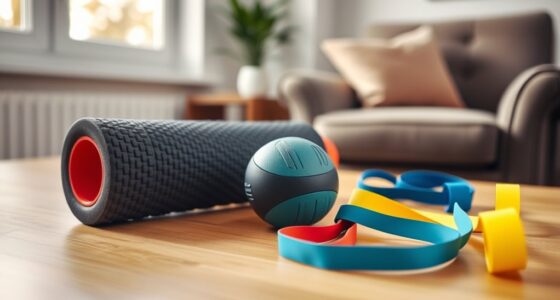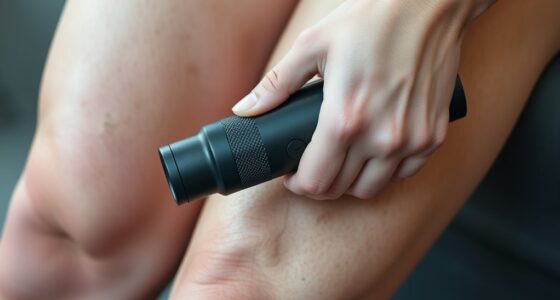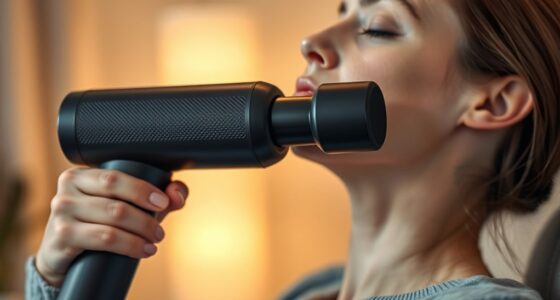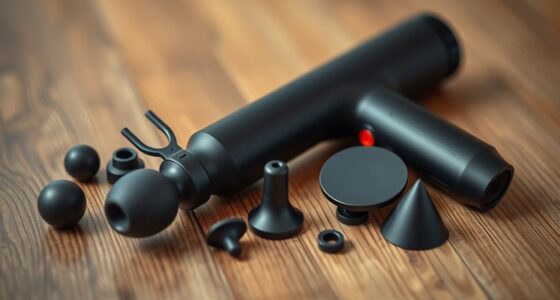Percussion therapy is a safe and effective way to support your healing process, but it’s important to use it properly. Always avoid applying it directly over open wounds, bruises, or inflamed areas, and target muscles around the injury instead. Use moderate intensity and don’t hold the device on one spot too long. When done correctly, it can help reduce pain and promote faster recovery. Keep exploring to learn how to use it effectively and safely.
Key Takeaways
- Apply percussion therapy to supporting muscles around the injury, not directly on damaged tissue.
- Use moderate intensity and avoid prolonged application to prevent irritation or setbacks.
- Follow healthcare provider’s guidance on timing, frequency, and specific techniques during healing.
- Ensure proper technique and avoid applying over open wounds, bruises, or inflamed areas.
- Combine percussion therapy with rest, nutrition, and physical therapy for optimal recovery.

Have you ever wondered how injured athletes speed up their recovery? One increasingly popular method is percussion therapy, a technique that uses rapid, rhythmic tapping to target sore muscles and tissues. When you’re dealing with an injury, your body needs to heal efficiently, and percussion therapy can be a valuable tool in your recovery arsenal. It promotes muscle recovery by stimulating blood flow, helping nutrients and oxygen reach damaged tissues faster. This process can reduce muscle stiffness and alleviate tightness, making movement less painful and more manageable during the healing process.
Pain relief is another significant benefit you can experience with percussion therapy. When you’re injured, pain often hampers your progress and can be discouraging. By applying percussion devices to affected areas, you can interrupt pain signals and relax tense muscles, which eases discomfort. The rhythmic impact helps release endorphins, your body’s natural painkillers, providing a sense of relief without relying solely on medication. As a result, you might find yourself able to perform gentle exercises or stretches sooner, supporting your overall recovery journey.
Percussion therapy releases endorphins, easing pain naturally and supporting quicker recovery.
Using percussion therapy safely during healing is essential. You should avoid applying it directly over open wounds, bruises, or inflamed tissues, as this could worsen your injury. Instead, target areas around the injury, focusing on muscles that support or are adjacent to the injured site. Keep the device at a moderate intensity, especially if you’re new to percussion therapy, and never hold it in one spot for too long—this can cause irritation or tissue damage. Always listen to your body; if you feel sharp pain or increased discomfort, stop immediately and consult your healthcare provider.
Incorporating percussion therapy into your recovery routine can accelerate muscle recovery and provide effective pain relief, but it’s not a standalone solution. It works best when combined with other treatments like rest, proper nutrition, and physical therapy. Make sure to follow your doctor’s advice on when and how to use percussion devices, especially during the delicate healing phase. Overdoing it may lead to setbacks, so moderation and proper technique are key. When used correctly, percussion therapy can be a safe, non-invasive way to enhance your recovery, reduce pain, and get you back to your active life sooner.
Frequently Asked Questions
Can Percussion Therapy Replace Traditional Physical Therapy?
You might wonder if percussion therapy can replace traditional physical therapy. While it’s an effective alternative therapy for muscle recovery, it shouldn’t fully replace professional treatment. Percussion therapy can complement your recovery plan, helping reduce soreness and improve circulation. However, for all-encompassing healing, you need the personalized guidance of a physical therapist. Use percussion therapy as part of your overall muscle recovery strategy, not as a sole solution.
How Often Should Injured Athletes Use Percussion Therapy?
You should follow the frequency guidelines provided by your healthcare provider or therapist, typically using percussion therapy 2-3 times a day. Keep session duration around 10-15 minutes to avoid overstimulation. Pay attention to your body’s response, and if you experience discomfort, reduce the frequency or duration. Consistency is key for healing, but always prioritize safety and consult a professional for personalized advice.
Are There Any Injuries That Contraindicate Percussion Therapy?
Just as some doors are locked tight, certain injuries are contraindicated for percussion therapy, limiting its use. You should avoid applying this treatment to fractures, deep vein thrombosis, infections, or open wounds, as these injuries can worsen with therapy. Always consult your healthcare provider to understand therapy limitations and make certain you’re not risking further harm, because not every injury is a green light for percussion therapy.
What Are the Signs of Overuse or Misuse During Therapy?
You should watch for signs of overuse or misuse during therapy, like increased muscle fatigue or skin irritation. If your muscles feel excessively sore or fatigued after sessions, it may indicate you’re pushing too hard. Skin irritation, redness, or discomfort also suggest you’re overdoing it. Always listen to your body, reduce intensity if needed, and consult a professional to avoid potential injury or setbacks.
Is Percussion Therapy Effective for Chronic Injuries or Only Acute Ones?
Imagine your muscles as a garden, weeds of chronic pain taking root over time. Percussion therapy acts like gentle rain, helping to break up tension and promote muscle relaxation. While it’s effective for acute injuries, it also offers relief for chronic pain by increasing circulation and reducing stiffness. So, yes, percussion therapy can be beneficial for long-term issues, providing ongoing support as you nurture your body’s healing process.
Conclusion
Percussion therapy can be a safe, effective way to support your healing process when used correctly. While some believe it accelerates recovery by increasing blood flow and reducing muscle tension, others worry about potential tissue damage if misused. The truth lies in moderation and proper technique. Always consult with a healthcare professional before incorporating it into your rehab routine. When used responsibly, percussion therapy can be a valuable tool to help you recover faster and get back in the game.









